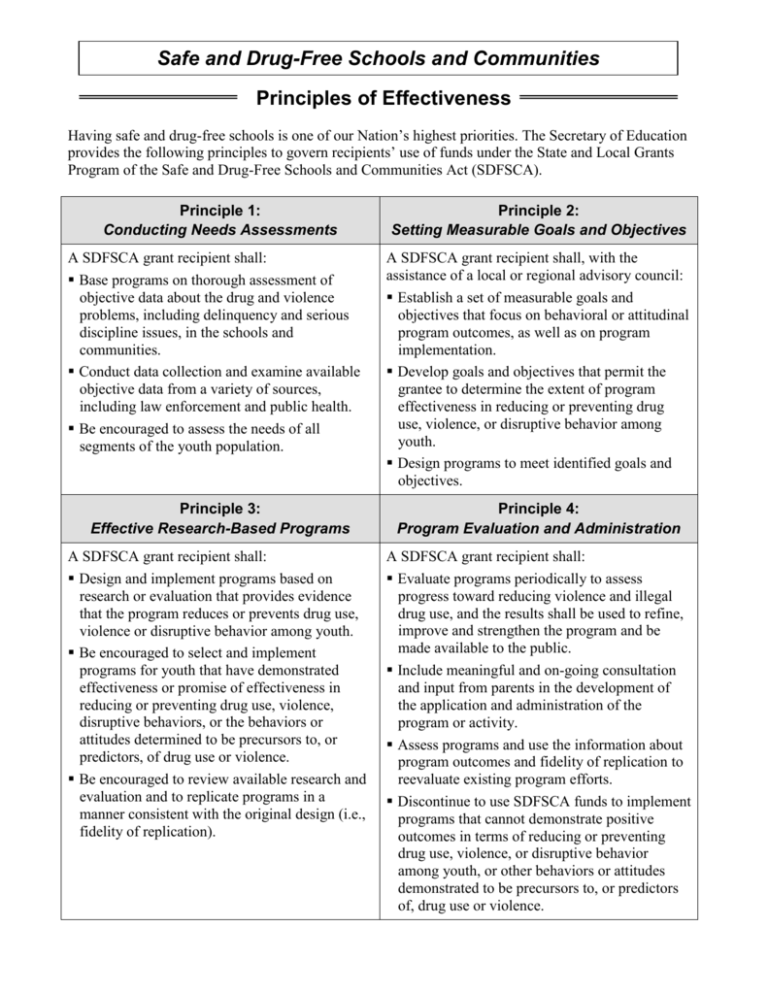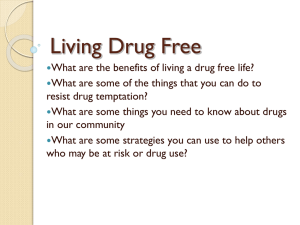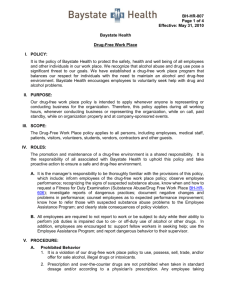Setting Measurable Goals and Objectives
advertisement

Safe and Drug-Free Schools and Communities Principles of Effectiveness Having safe and drug-free schools is one of our Nation’s highest priorities. The Secretary of Education provides the following principles to govern recipients’ use of funds under the State and Local Grants Program of the Safe and Drug-Free Schools and Communities Act (SDFSCA). Principle 1: Conducting Needs Assessments A SDFSCA grant recipient shall: Base programs on thorough assessment of objective data about the drug and violence problems, including delinquency and serious discipline issues, in the schools and communities. Conduct data collection and examine available objective data from a variety of sources, including law enforcement and public health. Be encouraged to assess the needs of all segments of the youth population. Principle 2: Setting Measurable Goals and Objectives A SDFSCA grant recipient shall, with the assistance of a local or regional advisory council: Establish a set of measurable goals and objectives that focus on behavioral or attitudinal program outcomes, as well as on program implementation. Develop goals and objectives that permit the grantee to determine the extent of program effectiveness in reducing or preventing drug use, violence, or disruptive behavior among youth. Design programs to meet identified goals and objectives. Principle 3: Effective Research-Based Programs Principle 4: Program Evaluation and Administration A SDFSCA grant recipient shall: Design and implement programs based on research or evaluation that provides evidence that the program reduces or prevents drug use, violence or disruptive behavior among youth. Be encouraged to select and implement programs for youth that have demonstrated effectiveness or promise of effectiveness in reducing or preventing drug use, violence, disruptive behaviors, or the behaviors or attitudes determined to be precursors to, or predictors, of drug use or violence. Be encouraged to review available research and evaluation and to replicate programs in a manner consistent with the original design (i.e., fidelity of replication). A SDFSCA grant recipient shall: Evaluate programs periodically to assess progress toward reducing violence and illegal drug use, and the results shall be used to refine, improve and strengthen the program and be made available to the public. Include meaningful and on-going consultation and input from parents in the development of the application and administration of the program or activity. Assess programs and use the information about program outcomes and fidelity of replication to reevaluate existing program efforts. Discontinue to use SDFSCA funds to implement programs that cannot demonstrate positive outcomes in terms of reducing or preventing drug use, violence, or disruptive behavior among youth, or other behaviors or attitudes demonstrated to be precursors to, or predictors of, drug use or violence. Safe and Drug-Free Schools and Communities Application Guidelines STEP ONE: The packet for the Safe and Drug-Free Schools and Communities Act Grant Application should include: Application Guidelines The Principles of Effectiveness WSESU FY Narrative Plan Summary Sheet The SDFSCA Grant Application Read these Guidelines first. STEP TWO: Review the Principles of Effectiveness, as further described below, and the WSESU FY Narrative Plan Summary Sheet: Principle 1 – Needs Assessment To help you select a program based on need and to provide objective data relative to need, here are a few resources to consider: Youth Risk Behavior Survey and other Office of Alcohol and Drug Abuse Program publications Community Profiles and other Agency of Human Services reports. Kids Count National and State Reports of the Annie E. Casey Foundation. www.ahs.state.vt.us www.aecf.org/kidscount/index.htm www.state.vt.us/adap David Murphey (802) 241-2238 Vermont Children's Forum (802) 229-6377 Healthy Vermonters 2010 and other Vermont Department of Health reports and publications Department of Education reports (e.g., annual school Act 51), publications and consultants for safe and healthy schools www.healthyvermonters.info Matt Myers (802) 828-5792. Local school and police records and reports related to alcohol, tobacco and other drug (ATOD) use and incidents of violence and disruptive behaviors. Kelly Hale (802) 651-1557 (802) 863-7300 A needs assessment should: provide information for prioritizing goals according to the unique circumstances of each school or community; identify the problems, the programs and services already in place, and why there is a need for a particular program. Objective data may also include: school records of absenteeism, suspension, dropout rates, teacher and counselor referrals… community-based referrals to drug-treatment programs, hospital visits related to ATOD… Principle 2 – Measurable Goals and Objectives Goals and objectives should focus on behavioral or attitudinal program outcomes (short and long-term objectives) as well as on program implementation (process objectives, e.g., the quality of implementation; tracking activities, participants, hours; etc.). Goals set the direction for work to be performed. Key questions include: What do you hope to accomplish? What is the ultimate outcome of the program? Examples: To reduce drug and alcohol use among middle school students. To increase pro-social skills in elementary students. To reduce the incidents of harassment and bullying in the high school. Objectives are accomplishments to be achieved during a given time period. They help to attain goals by translating a general purpose into a series of specific, manageable steps. Objectives need to be SMART: Specific – describe action and target population to be addressed Measurable – describe increases or decreases to take place in terms of numbers or percentages Attainable – can the objectives be attained as stated and in the timeframe given Safe and Drug-Free Schools and Communities - Application Guidelines Page 2 Realistic – are the objectives overstated or realistic for the program and the population Time bound – what is the time frame for achieving the objectives, by what specific end date Example: By June 2003, at least 50% of 6th grade students will demonstrate increased negotiation and refusal skill development through classroom implementation of the Life Skills Training curriculum. (Possible evaluation tools include observation checklists and/or self-reports.) Principle 3 – Effective Research-Based Programs Many programs exist that show evidence of reducing ATOD use, delaying risk-taking behaviors, or changing knowledge and attitudes related to ATOD and bullying or violence. For a list of substance abuse and mental health programs that have proven to prevent or decrease substance abuse and other high-risk behaviors in communities and schools across the nation, visit SAMHSA at www.modelprograms.samhsa.gov. Note: If the program you are proposing does not have current evidence of effectiveness, cite research and evaluation that indicates your program may hold promise of changing attitudes, behavior and/or knowledge. Also, provide evaluation tools (e.g., pre and post-tests) to demonstrate program efficacy. Principle 4 – Evaluation and Administration Identify the methods proposed to verify the intended results (outcomes/objectives). Indicate how you will assess the program “mid-course” to determine its effectiveness. Demonstrate parent involvement in the development and administration of the program or activity. Some clarifying questions include: What changes in youth will you observe and/or hear? How will you document these changes? What tools will you use to demonstrate achievement of objectives? If the program does not meet intended objectives, what changes are you prepared to make to the program, or if necessary, to the objectives? How are you involving parents? What communication will go from the school to parents? STEP THREE: Provide as much detail as possible of the proposed and itemized costs. If necessary, use a separate piece of paper. Indicate if other funding sources will support the program. STEP FOUR: Do you know if your school has a school-site health action committee? If not, ask your principal. Since your proposed program affects the health and, possibly, the safety of the learning environment, sharing your proposal with others can potentially strengthen the effects of your program. It is always best to coordinate new programs with existing efforts. Remember, a single classroom still exists within the realm of the whole school. Positive effects can ripple out to others! If you would like to discuss your project with Pamela Corbett, the Regional Tobacco Coordinator and WSESU Health Specialist, call her at (802) 251-2127. Robin Rieske, ADAP Prevention Consultant, can also be consulted for grant-related questions. Robin can be reached by phone at (802) 257-2885. STEP FIVE: Please provide the two signatures requested. STEP SIX: Send one copy (typed or legibly written) -- by the deadline indicated on the grant -- to Paul Smith, WSESU Central Office, 53 Green St., Brattleboro, VT 05301. Note: Due to limited funds and Safe and Drug-Free Schools & Communities Act requirements, all applications will be considered, but all may not be funded. Applicants will be notified in writing.










